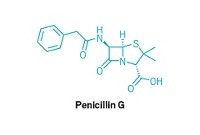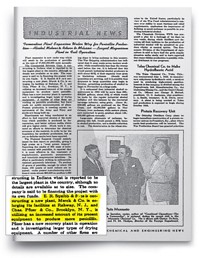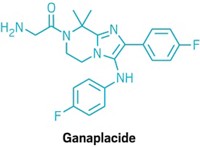Advertisement
Grab your lab coat. Let's get started
Welcome!
Welcome!
Create an account below to get 6 C&EN articles per month, receive newsletters and more - all free.
It seems this is your first time logging in online. Please enter the following information to continue.
As an ACS member you automatically get access to this site. All we need is few more details to create your reading experience.
Not you? Sign in with a different account.
Not you? Sign in with a different account.
ERROR 1
ERROR 1
ERROR 2
ERROR 2
ERROR 2
ERROR 2
ERROR 2
Password and Confirm password must match.
If you have an ACS member number, please enter it here so we can link this account to your membership. (optional)
ERROR 2
ACS values your privacy. By submitting your information, you are gaining access to C&EN and subscribing to our weekly newsletter. We use the information you provide to make your reading experience better, and we will never sell your data to third party members.
Pharmaceuticals
Antibacterial History
Number of successful antibacterial classes discovered per decade
by Michael Torrice
September 9, 2013
| A version of this story appeared in
Volume 91, Issue 36
COVER STORY
Antibacterial History
1928 Alexander Fleming discovers penicillin.
Penicillin doesn’t become a viable drug until the early 1940s, after work in part by a team of Oxford University scientists.
1932 Prontosil, the first sulfonamide drug, is discovered in Germany.
Gerhard Domagk developed the drug from a dye that stained bacteria red.
1943 Selman A. Waksman and Albert Schatz discover streptomycin.
Waksman coined the term “antibiotic” as a compound produced by an organism to kill or inhibit the growth of other organisms.
1945 Chlortetracycline is discovered at American Cyanamid.
The drug is the first tetracycline, a class of drugs that inhibit protein synthesis.
1945 Columbia University scientists identify bacitracin.
The peptide antibiotic came from Bacillus bacteria that the team isolated from a patient named Tracy. They named bacitracin after her.
1947 First polymyxin peptide antibiotic is discovered.
Despite kidney toxicity, colistin, a polymyxin discovered in 1949, is often used today as a last resort against multi-drug-resistant bacteria.
1948 First cephalosporin-producing fungus isolated.
Italian scientists found the fungus growing in seawater near a sewage outlet on the island of Sardinia. Several years later, Oxford University scientists isolated cephalosporin C, the prototype of a class that includes the drug Keflex.
1950 Pleuromutilin is discovered in a Clitopilus fungus.
Although analogs of this compound have been used in veterinary medicine for decades, the first human drug, retapamulin, wasn’t approved until 2007.
1952 Isoniazid’s antituberculosis activity is identified.
The drug leads to greater than 90% cure rates for TB, a disease that was a leading killer at the start of the 20th century.
1952 Scientists at Eli Lilly & Co. isolate erythromycin A.
The compound came from bacteria in a soil sample collected from Iloilo, the Philippines. It is the prototype of the macrolide class of antibacterial drugs.
1953 Vancomycin is discovered by Lilly scientists.
The glycopeptide is often used today as a drug of last resort in patients with serious infections.
1957 First rifamycin is isolated.
The Italian scientists who discovered the compound named the class, which includes the TB drug rifampicin, after a 1955 French crime movie called “Rififi.”
1962 Nalidixic acid is discovered at Sterling-Winthrop Research Institute.
Nalidixic acid, the first quinolone antibacterial drug, was originally synthesized in the late 1940s. The quinolones, which include the drug Cipro, gum up DNA synthesis by inhibiting DNA topoisomerases.
1975 Researchers at Lepetit discover lipiarmycin.
The scientists made their discovery on Feb. 29, so they named the compound after the leap year—it’s pronounced leap-year-mycin. The class didn’t hit the market until FDA approved fidaxomicin in 2011.
1978 DuPont patents oxazolidinones.
But DuPont abandoned the class because of toxicity concerns. Chemists at Upjohn solved the toxicity problems, and linezolid, the first oxazolidinone drug, was approved by FDA in 2000.
1987 Lilly publishes first data on daptomycin.
Cubist Pharmaceuticals licensed the lipopeptide from Lilly, and daptomycin was approved in 2003.
2005 Bedaquiline is first reported.
FDA approved the drug in 2012, making it the first new TB drug class approved in more than 40 years.
MORE ON THIS STORY
Introduction: Nine For Ninety | PDF
Chemical Connections | PDF
Antibacterial Boom And Bust | PDF
Small Science, Big Future | PDF
Understanding The Workings Of Life | PDF
Chemistry By The Numbers | PDF
Plastic Planet | PDF
The Catalysis Chronicles | PDF
Giving Chemists A Helping Hand | PDF
It's Not Easy Being Green | PDF
Readers' Favorite Stories | PDF
Nine Decades Of The Central Science | PDF
How Chemistry Changed the World | C&EN's 90th Anniversary Poster Timeline
Trying To Explain A Bond
A Toast To C&EN At 90





Join the conversation
Contact the reporter
Submit a Letter to the Editor for publication
Engage with us on Twitter